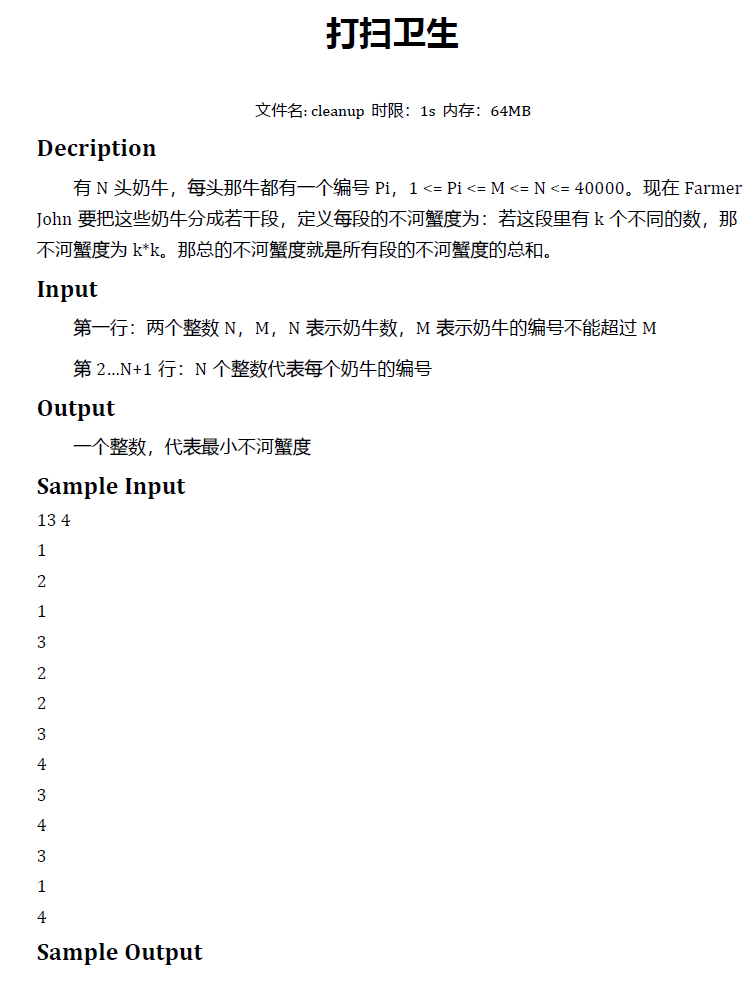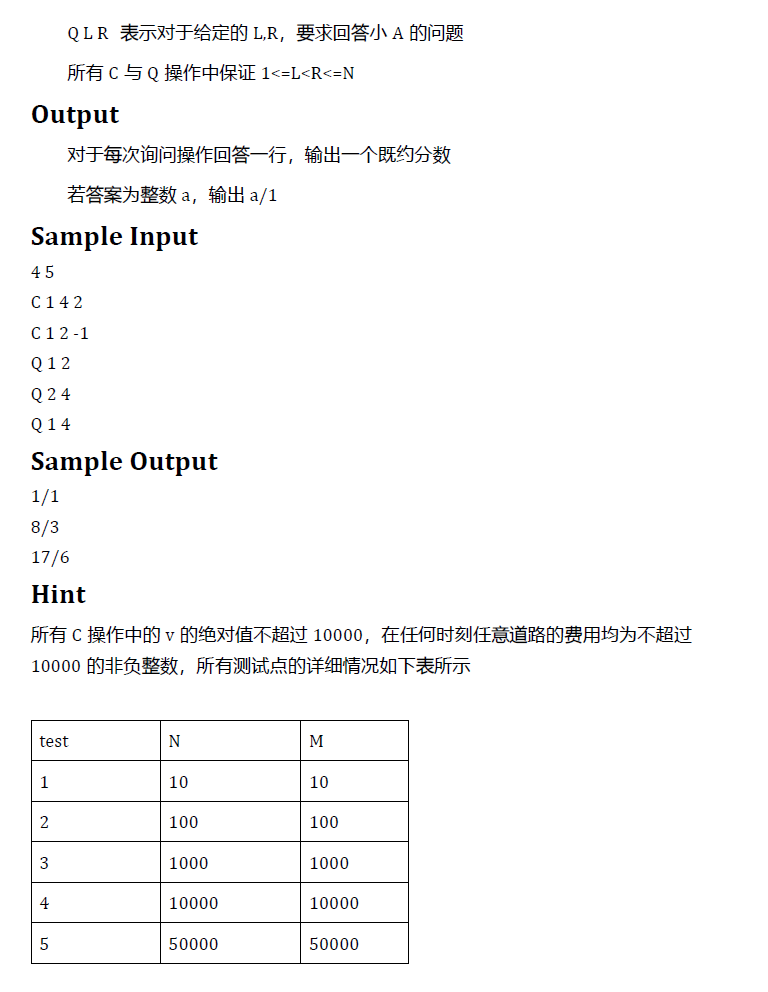【11.5校内测试】【倒计时5天】【DP】【二分+贪心check】【推式子化简+线段树】


Solution
非常巧妙的建立DP方程。
据dalao们说题目明显暗示根号复杂度??(反正我是没看出来
因为每次分的块大小一定不超过$\sqrt n$,要不然直接每个位置开一个块答案都才为$n$。
于是大佬们想到用一个非常巧妙的数组$pos[j]$,表示顺推到当前位置$i$时,以$i$作为右端点,区间出现了$j$个颜色的左端点的位置。
于是每次转移就变成了$dp[i]=min(dp[pos[j]-1]+j*j)$,而不需要把之前全部枚举。$j$的范围就是$<=\sqrt n$的。
所以每次新到一个位置,就对于每个$j$看是否有新的贡献,记录$cnt[j]$表示$pos[j]$到$i$当前实际有多少个颜色。
如果$cnt[j]>j$表示当前$pos[j]$需要往后移动更新,那么每次往后一位一位暴力移动查询当前位置是否可以作为$pos[j]$,就是判断这个位置之后,$i$之前是否还出现了这个位置的颜色,如果出现了那么这个位置就不能作为$pos[j]$,因为它后面还有贡献。(据说均摊复杂度O(n)??)
细节通过双向链表处理。
Code
#include<bits/stdc++.h> #define LL long long #define RG register using namespace std; LL dp[40005]; int nxt[40005], a[40005], pre[40005], las[40005], pos[40005], cnt[40006]; int n, m; int main() { freopen("cleanup.in", "r", stdin); freopen("cleanup.out", "w", stdout); scanf("%d%d", &n, &m); for(int i = 1; i <= n; i ++) { scanf("%d", &a[i]); pre[i] = las[a[i]]; nxt[las[a[i]]] = i; las[a[i]] = i; nxt[i] = n + 1; } memset(dp, 0x3f3f3f3f, sizeof(dp)); dp[0] = 0; int siz = sqrt(n); for(int i = 1; i <= siz; i ++) pos[i] = 1; for(RG int i = 1; i <= n; i ++) { for(RG int j = 1; j <= siz; j ++) { if(pre[i] < pos[j]) cnt[j] ++; if(cnt[j] > j) { cnt[j] --; while(nxt[pos[j]] < i) pos[j] ++; pos[j] ++; } dp[i] = min(dp[pos[j] - 1] + j * j, dp[i]); } } printf("%lld", dp[n]); return 0; }


Solution
二分性很明显,但是check竟然是用搜索回溯处理???真实震惊
搜索大概就是每次在剩下没有被覆盖的点中找到最靠左、最靠右、最靠下、最靠上四个极点位置,然后每次贪心往四个角(左上、左下、右上、右下)填矩阵,更新剩下没覆盖的点,搜三层回来即可.....
真的好玄学啊QAQ但是就是过了QAQ
Code
#include<bits/stdc++.h> #define oo 0x3f3f3f3f #define LL long long using namespace std; int n, xmi, xma, ymi, yma, MA; struct Node { LL x, y; } tr[20005]; bool cmp1(Node a, Node b) { return a.x < b.x; } bool cmp2(Node a, Node b) { return a.y < b.y; } bool flag, vis[20005]; LL now; void dfs(int dep, int tot) { if(tot == n) { flag = 1; return ; } if(dep == 3) return ; bool used[20005] = {0}; LL maxx = -oo, minx = oo, maxy = -oo, miny = oo; for(int i = 1; i <= n; i ++) { if(vis[i]) continue; maxx = max(maxx, tr[i].x); minx = min(minx, tr[i].x); maxy = max(maxy, tr[i].y); miny = min(miny, tr[i].y); } int cnt = 0; LL xl = minx, xr = minx + now, yl = miny, yr = miny + now; cnt = 0; for(int i = 1; i <= n; i ++) { if(vis[i]) continue; if(tr[i].x <= xr && tr[i].x >= xl && tr[i].y >= yl && tr[i].y <= yr) { vis[i] = 1; used[i] = 1; cnt ++; } } dfs(dep + 1, tot + cnt); if(flag) return ; for(int i = 1; i <= n; i ++) if(used[i]) vis[i] = used[i] = 0; xl = minx, xr = minx + now, yl = maxy - now, yr = maxy; cnt = 0; for(int i = 1; i <= n; i ++) { if(vis[i]) continue; if(tr[i].x <= xr && tr[i].x >= xl && tr[i].y >= yl && tr[i].y <= yr) { vis[i] = 1; used[i] = 1; cnt ++; } } dfs(dep + 1, tot + cnt); if(flag) return ; for(int i = 1; i <= n; i ++) if(used[i]) vis[i] = used[i] = 0; xl = maxx - now, xr = maxx, yl = maxy - now, yr = maxy; cnt = 0; for(int i = 1; i <= n; i ++) { if(vis[i]) continue; if(tr[i].x <= xr && tr[i].x >= xl && tr[i].y >= yl && tr[i].y <= yr) { vis[i] = 1; used[i] = 1; cnt ++; } } dfs(dep + 1, tot + cnt); if(flag) return ; for(int i = 1; i <= n; i ++) if(used[i]) vis[i] = used[i] = 0; xl = maxx - now, xr = maxx, yl = miny, yr = miny + now; cnt = 0; for(int i = 1; i <= n; i ++) { if(vis[i]) continue; if(tr[i].x <= xr && tr[i].x >= xl && tr[i].y >= yl && tr[i].y <= yr) { vis[i] = 1; used[i] = 1; cnt ++; } } dfs(dep + 1, tot + cnt); if(flag) return ; for(int i = 1; i <= n; i ++) if(used[i]) vis[i] = used[i] = 0; } bool check(LL mid) { now = mid; flag = 0; for(int i = 1; i <= n; i ++) vis[i] = 0; dfs(0, 0); return flag; } LL erfen() { LL l = 0, r = 100000000000, ans; while(l <= r) { LL mid = (l + r) >> 1; if(check(mid)) ans = mid, r = mid - 1; else l = mid + 1; } return ans; } int main() { freopen("cover.in", "r", stdin); freopen("cover.out", "w", stdout); scanf("%d", &n); for(int i = 1; i <= n; i ++) scanf("%lld%lld", &tr[i].x, &tr[i].y); LL ans = erfen(); printf("%lld", ans); return 0; }


Solution
区间修改??发现没那么简单QAQ,是求多个区间的和,没办法直接修改就快速求出答案。
所以推一推式子将$n^3$优化到$n^2$,要求的区间的区间和实际上可以由每条边的贡献算出来:$\sum_{i=L}^{R}{v[i]*(i-L+1)*(R-i+1)}$,此处$R$是事先$--$了的,因为$R-R+1$的边不能被算入贡献。
化简得$\sum{iv[i] * (L + R) - i^2v[i] + v[i] * (R - L * R + 1 - L)}$所以要维护的变量实际上只有$iv[i].i^2v[i].v[i]$三个的区间和即可,用一颗线段树结构体就好辣。
全都要开longlong才可以!!
Code
#include<bits/stdc++.h> #define LL long long using namespace std; LL n, m; LL gcd(LL a, LL b) { return b == 0 ? a : gcd(b, a % b); } struct Node { LL iv, v, iv2; Node operator + (const Node &a) const { Node c; c.iv = iv + a.iv; c.v = v + a.v; c.iv2 = iv2 + a.iv2; return c; } } TR[400005]; LL tag[400005], iv[100005], iv2[100005]; void push_down(LL nd, LL l, LL r) { if(tag[nd]) { LL d = tag[nd], mid = (l + r) >> 1; TR[nd << 1].iv += d * (iv[mid] - iv[l - 1]); TR[nd << 1].iv2 += d * (iv2[mid] - iv2[l - 1]); TR[nd << 1].v += d * (mid - l + 1); TR[nd << 1 | 1].iv += d * (iv[r] - iv[mid]); TR[nd << 1 | 1].iv2 += d * (iv2[r] - iv2[mid]); TR[nd << 1 | 1].v += d * (r - mid); tag[nd << 1] += d, tag[nd << 1 | 1] += d; tag[nd] = 0; } } void update(LL nd) { TR[nd] = TR[nd << 1] + TR[nd << 1 | 1]; } void modify(LL nd, LL l, LL r, LL L, LL R, LL d) { if(l >= L && r <= R) { TR[nd].iv += d * (iv[r] - iv[l - 1]); TR[nd].iv2 += d * (iv2[r] - iv2[l - 1]); TR[nd].v += d * (r - l + 1); tag[nd] += d; return ; } push_down(nd, l, r); LL mid = (l + r) >> 1; if(L <= mid) modify(nd << 1, l, mid, L, R, d); if(R > mid) modify(nd << 1 | 1, mid + 1, r, L, R, d); update(nd); } Node query(LL nd, LL l, LL r, LL L, LL R) { if(l >= L && r <= R) return TR[nd]; push_down(nd, l, r); LL mid = (l + r) >> 1; Node ans; ans.iv = ans.iv2 = ans.v = 0; if(L <= mid) ans = ans + query(nd << 1, l, mid, L, R); if(R > mid) ans = ans + query(nd << 1 | 1, mid + 1, r, L, R); return ans; } void init() { for(LL i = 1; i <= n; i ++) { iv[i] = iv[i - 1] + i; iv2[i] = iv2[i - 1] + i * i; } } int main() { freopen("roadxw.in", "r", stdin); freopen("roadxw.out", "w", stdout); scanf("%lld%lld", &n, &m); init(); for(LL t = 1; t <= m; t ++) { char s[10]; LL L, R, V; scanf("%s", s); if(s[0] == 'C') { scanf("%lld%lld%lld", &L, &R, &V); modify(1, 1, n, L, R - 1, V); } else { scanf("%lld%lld", &L, &R); R --; Node a = query(1, 1, n, L, R); LL ans = a.iv * (L + R) - a.iv2 + a.v * (R - L * R + 1 - L); LL tot = R - L + 2; LL ans2 = tot * (tot - 1) / 2; LL d = gcd(ans, ans2); ans /= d, ans2 /= d; printf("%lld/%lld\n", ans, ans2); } } return 0; }

